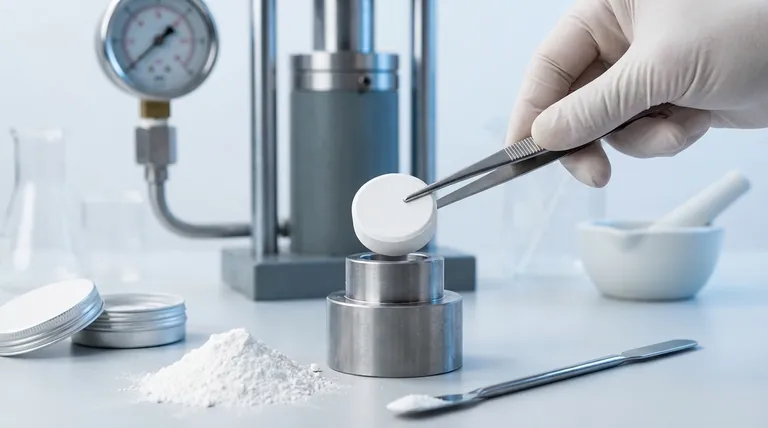压片技术的核心是一种材料加工方法,用于将松散的粉末转化为致密、固体且几何形状均匀的圆盘,称为压片。这通过将粉末限制在圆柱形模具中,并在高压下(通常使用液压机)进行压实来实现。结果是比原始粉末更容易处理和分析的固体样品。
压片技术的核心挑战不仅仅是施加压力,而是管理力、样品体积和模具几何形状之间的精确关系,以创建完美、均匀的压片,同时不损坏设备。
为什么要使用压片技术?
这种方法在许多科学和工业领域中至关重要,因为它解决了处理粉末的问题。它使样品形式标准化,以便进行分析和进一步加工。
制备用于分析的均匀样品
对于像FTIR(傅里叶变换红外)光谱或XRF(X射线荧光)这样的分析技术,样品必须是均匀的。压片提供了一致的厚度和密度,确保测量结果具有可重复性并能代表整体材料。
例如,在FTIR中,样品粉末通常与透明盐(如溴化钾 (KBr))混合。压制这种混合物会形成一个透明的压片,允许红外光束以最小的散射通过。
提高材料密度和处理能力
松散的粉末难以处理、测量和运输。将它们压实成固体压片可形成耐用、高密度的形状,该形状尺寸稳定且易于管理。
制备烧结前体
在陶瓷和粉末冶金中,“生坯”是通过将粉末压制成所需形状而制成的。这些压片致密但未完全结合。然后,它们在称为烧结的过程中加热,使颗粒熔合在一起,形成最终的坚固部件。

核心过程:从粉末到压片
制作高质量的压片需要仔细注意过程中的每个步骤,从最初的材料处理到最终的施力。
步骤1:材料准备
起始粉末必须极其细小和干燥。任何大颗粒或水分都可能在最终压片中造成裂纹或浑浊等缺陷。对于分析压片,此步骤通常涉及在玛瑙研钵和研杵中将样品与稀释剂(如KBr)一起研磨。
步骤2:装载模具
将粉末小心地装入压片模具的主体中,该模具由底座、圆柱形主体和一个或两个冲头组成。粉末的均匀分布对于确保最终压片具有均匀密度至关重要。
步骤3:施加压力
将装载好的模具放入液压机中。缓慢而有意识地施加压力,以使被困空气逸出。最终压力可以从几吨到十多吨不等,具体取决于材料和所需密度。
步骤4:弹出和处理
释放压力后,小心地将压片从模具中弹出。成品压片通常很脆弱,应使用镊子处理,特别是如果它用于敏感分析。
了解关键权衡
这项技术的成功取决于平衡相互竞争的因素。参考信息强调了最关键的关系:力与样品体积。
施加力的影响
施加足够的力对于将粉末压实成连贯、坚固的压片是必要的。然而,过度用力是一个常见的错误。它可能导致压片内部出现应力裂纹,或者在分析压片的情况下,产生密度过高且不透明的样品,无法进行分析。
管理压片高度和体积
您使用的粉末量直接决定了最终压片的高度。当您接近压机或模具组的推荐载荷时,您必须仔细管理这一点。在强大压力下非常厚的压片会集中应力,并导致分层,即压片分离成多层。
这就是为什么在接近设备极限时,通常需要降低力或降低压片高度。使用更少的粉末或更短的冲头可确保压力有效分布,而不会超过模具的机械公差。
设备完整性和安全性
通过使用过多的粉末和过大的力将设备推到其规定极限之外,可能会导致模具组的灾难性故障。冲头或模具主体可能会破裂,造成重大的安全隐患和昂贵的更换成本。
根据您的目标做出正确选择
您对压片技术的处理方法应由您的最终目标决定。
- 如果您的主要重点是分析清晰度(例如,FTIR):优先考虑均匀研磨和与KBr彻底混合,并仅使用足够的压力来创建透明、无裂纹的压片。
- 如果您的主要重点是机械强度(例如,陶瓷生坯):通过使用受控的高压并确保在压制阶段排出所有被困空气来集中精力实现最大密度。
- 如果您的主要重点是设备安全和寿命:始终遵守制造商推荐的载荷限制,如果您接近这些限制,请降低施加的力或样品粉末量(压片高度)。
最终,掌握这项技术是控制的练习,将无序的粉末转化为精确设计的固体。
总结表:
| 方面 | 关键考虑 |
|---|---|
| 主要用途 | 用于分析(FTIR、XRF)的样品标准化以及制备烧结前体。 |
| 核心过程 | 将粉末限制在模具中;使用液压机施加高压。 |
| 关键因素 | 平衡施加的力与样品体积,以避免裂纹或设备损坏。 |
| 适用于 | 需要从粉末中获得一致、高密度样品的实验室。 |
准备好实现完美的样品制备了吗?
压片技术是可靠分析结果和材料加工的基础。KINTEK专注于提供高质量的实验室设备和耗材——包括液压机、压片模具和研磨材料——您需要掌握这种方法。
立即通过我们的联系表联系我们,讨论您的具体应用。我们的专家将帮助您选择合适的设备,以确保您的压片均匀、致密且完美制备,以进行准确分析和稳健的材料合成。
图解指南




















